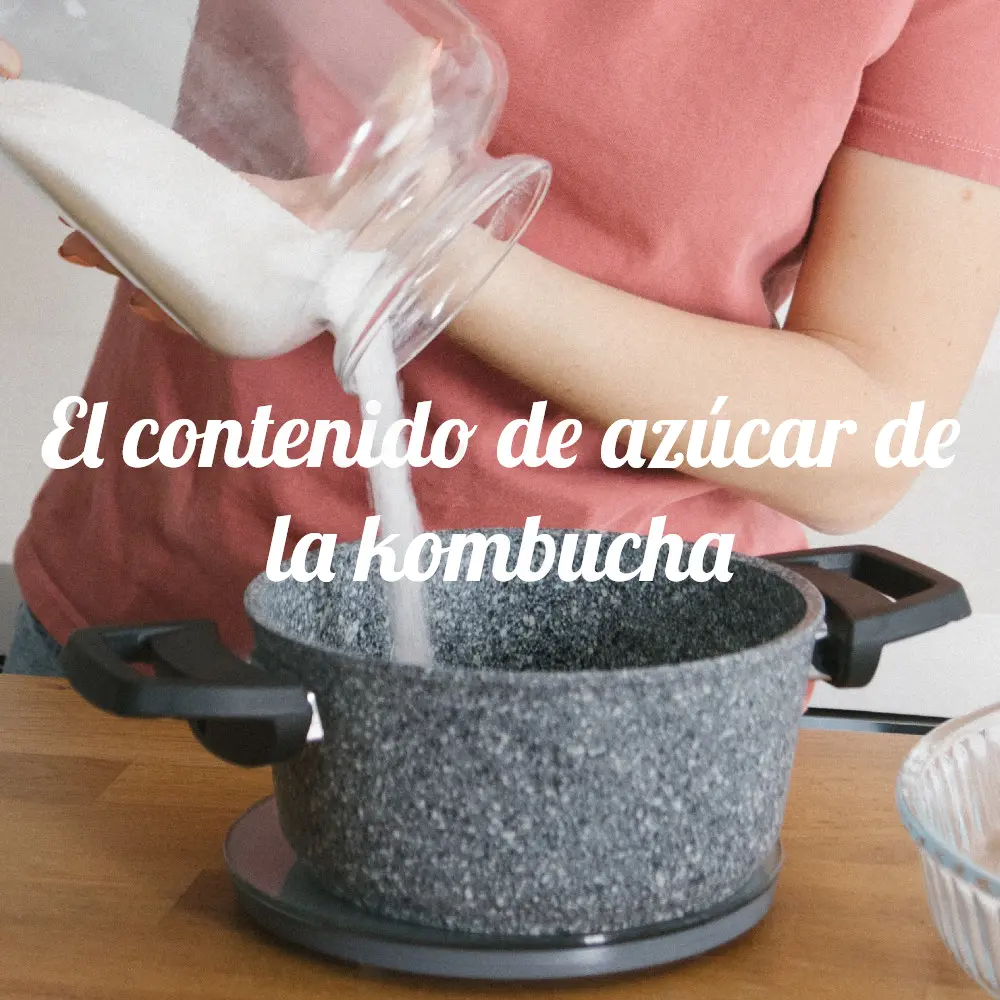Sugar is a key ingredient in the preparation of kombucha, it is responsible for feeding the necessary bacteria and yeasts, in addition to sweetening the drink. Even so, the composition and amount of sugar used at the beginning of fermentation is different at the end or during it, often generating unwanted changes in the concentration of sugars.
Many times variable amounts of sugar are added, usually 55g per liter of tea, which function as a substrate in the formation of the product, but this depends not only on the microorganisms, but also on the conditions and fermentation media used. [1] [2]
Different types of tea can be used in kombucha that generate different results in the concentration of sugars, but regardless of which is prepared, sucrose always predominates at the beginning so that after 7 to 14 days glucose and fructose predominate.
These changes in carbohydrate levels may or may not be a problem, depending on the frequency of consumption, the number of cups consumed and added sugars, since excess is dangerous in people who are insulin resistant, have heart or digestive problems.
What is the sugar content in kombucha?
Kombucha drinks can vary the concentration of carbohydrates due to the number of added sugars or the continuous fermentation of the product, even after its preparation is finished and it has gone on sale.
In a study, several commercial kombucha products were analyzed where a range of 6 to 13 grams of sugars per serving was observed, demonstrating a higher-than-expected content, on average it was more than 20% of the figure indicated on the product label. [2]
These values can change depending on the duration of fermentation and the type of tea used, finding a higher concentration of sugar in its red tea compared to black and green tea, which have a higher consumption of sugars (38-41% of total sugars), after 14 days. [3] [4]
Other sources of sugar such as palm sugar and molasses can be healthier because they contain a lower percentage of sucrose compared to refined sugar, which is commonly used in the preparation of kombucha. [4]
We also have the unflavored kombucha, with less added sugars, which contain 2 to 3 grams of sugar per 240 ml of drink. [1]
Although in some cases there are no risks, consumption should be avoided in the presence of certain diseases or regular consumption to prevent the onset of others.
Why does the sugar content vary during fermentation?
The sugar content changes depending on the fermentation time and the SCOBY (culture of microorganisms), carbohydrates are metabolized at different rates by microorganisms changing the composition of sugars in the drink.
At the beginning of the fermentation there is a high content of sucrose from the added sugar, then this decreases progressively because it is hydrolyzed by the yeasts of the SCOBY, generating an increase in glucose and fructose, being quite high around the 4th day of fermentation and then decreasing the following days.
This happens because yeast uses sucrose to produce ethanol and acetic acid bacteria use glucose to produce cellulose, as well as acetic acid, also explaining why the latter is at the minimum at the end of fermentation leaving a rather acidic drink. [5]
Therefore, the sugar content tends to decrease as the fermentation time increases, although the exact calculation of how much sugar is in kombucha is totally uncertain since it will depend, in addition to fermentation time, on the bacterial composition of the kombucha.
It is even possible that a kombucha can contain more than 43 grams of sugar (equivalent to 11 teaspoons of sugar), and others less than 3 grams per serving, raising doubts about which product may be the most suitable. [1] [6]
We can also see this in our article on the alcohol content of kombucha, when we saw the graph of the variation of the alcohol content in kombucha, we could also see how sucrose decreased and fructose increased.
What sources of sugar can be used for fermentation?
Refined white sugar is the energy source commonly used in kombucha, but there have been studies with other sources of sugar that have been shown to be healthier allowing to obtain a product with lower sugar content and maintain the pleasant flavor of kombucha.
The use of palm sugar (PA) and molasses sugar (MA) in the preparation of kombucha tea with black tea was observed in an analysis and a glucose content of 2% in the AP and 1% in the AM was determined compared to 3% obtained with white sugar, although the AP contains the highest percentage of fructose with 2%.
It was concluded that AP and AM are good alternatives to refined sugar and other sugars commonly used in fermentation. [7] [8]
Another study investigated the use of molasses honey to speed up the fermentation process of kombucha compared to sucrose and observed a steady decrease in fructose and glucose, but leaving intact the concentrations of melezitose, isomaltulose and maltose that were not metabolized by the bacteria in the culture. [9]
Other sugars that could be used as alternative sweeteners are artificial sweeteners, brown sugar, glucose, kitul palm honey and sucrose. [10]
What health problems can the consumption of very sugary kombucha bring?
The World Health Organization recommends a consumption of less than 10% of added sugars with respect to total calories and the institute of medicine recommends less than 25%, since several studies have shown that added sugars, mainly sugary drinks, increase the risk of obesity, hypertension, cardiovascular disease, type 2 diabetes mellitus and dyslipidemias. [11]
Other analyses also link excessive consumption of these sugars to non-alcoholic fatty liver disease (NAFLD), cognitive impairment and some cancers. A strong relationship was found in the reduction of the consumption of sugary drinks with a lower risk of presenting NAFLD. [12] [13]
Although it has also been pointed out that added sugars alone are not the ones that predispose these diseases, a high consumption of fats or other types of refined carbohydrates is also involved, being necessary to reduce both components in the diet to obtain a good prevention and improvement of health.12
As we saw in the article on irritable bowel and kombucha, it contains FODMAP carbohydrates (oligo-di-mono-polyols), which are related to digestive problems causing diarrhea, pain, bloating and the severity of symptoms in people suffering from irritable bowel syndrome (IC). [14]
Therefore, as a recommendation I could tell you to let kombucha ferment its time, and always consume the recommended daily dose so as not to exceed any limit.
I tell you the above, because many people on the third or fifth day of fermentation want to take it because it is sweet and rich, because its sugar content has not decreased, and also its alcohol content is on track to reach its maximums.
For now, that’s all I can tell you. If I have missed something you would like to know about it let me know, and I will try to answer it as soon as I can, and for now, I leave you much more content that you may love.

